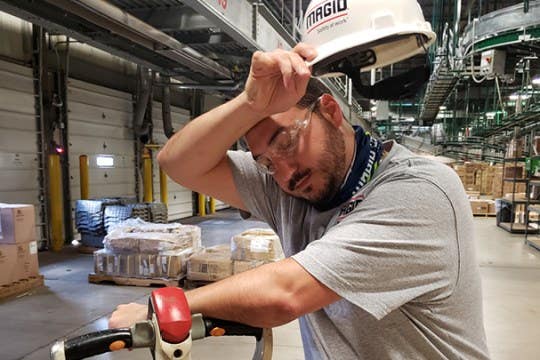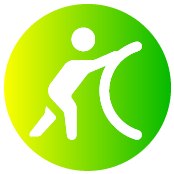
Preventing Overexertion on the Job
By John Heniff, Safety Writer, Magid
We all appreciate it when our employees work hard. But working too hard can cause more harm than good. In 2020, over 255,000 worker injuries were attributed to overexertion, according to the National Safety Council (NSC). Overexertion occurs in many different forms on the jobsite, but it can usually be prevented through universal good habits.
Here are three common causes of overexertion injuries along with some easy ways you can keep your people from developing long-term or chronic conditions because of them:


EXCESSIVE EFFORT INJURY
-
Straining when holding/carrying a heavy object like a box or crate
-
Pulling a muscle when pushing a cart
-
Sudden movements that can damage a muscle


REPETITIVE STRAIN INJURY
-
Using tools or performing tasks that require repetitive motion without a break
-
Poor posture or body positioning during the workday


PROLONGED BODY MOTION INJURY
-
Working in unnatural or awkward positions for long periods of time without a break, such as working in a tight or confined space
PREVENTING OVEREXERTION INJURIES
1. PLAN BEFORE YOU MOVE
Train your workers to use their brains before they use their muscles. Have them consider the type of material they’re moving as well as the size, shape, and weight of the object(s). Only after considering factors like the size of the object and if it’s slippery or slick should they employ their own strength and energy. By thinking ahead, they can find the smartest way to get the job done without putting themselves or others at risk of injury.
2. USE THE "BIG TOE TEST"
An easy way to tell if an object is too heavy for a worker to move alone is if it fails the “Big Toe Test.” That is, if a worker can easily move it with a push from their big toe, it’s probably light enough to be safely picked up and moved around. However, if it fails this test, the object is too heavy for them to move alone.
3. EASE INTO IT
The greatest effort needed when pushing an object is the initial push to get it moving. But pushing with too much force can lead to overexertion and injuries to muscles, tendons, and ligaments. Teach workers to gradually ease into the initial push and sustain control rather than rushing into the object or giving it a sudden, forceful push.
4. USE PROPER ERGONOMICS
Pushing while in an awkward posture puts workers at increased risk for injury. Teach your people to face the middle of the object instead of the top or the bottom. Getting them to push with their back straight, knees bent, and core tight while using their legs and bodyweight is the best way to move large, heavy objects.
5. PUSH, DON'T PULL, WHENEVER YOU CAN
While pushing can cause injuries, emphasize that it’s still safer to push an object rather than pull it because pushing utilizes less effort from the muscles, especially in the lower back and shoulders. Pushing can also give workers better visibility in front of them and allows them to apply more force by leaning their weight into the push rather than away from it while pulling.
6. GET HELP FROM A TEAMMATE OR ON-SITE EQUIPMENT
Remind your workers that they aren’t superheroes (even though some may think they are). They don’t have to shoulder all the weight or overexert themselves to the point of injury. Remind them to avoid taking risks by asking for help or using equipment like a pallet jack or hand truck to move heavy objects safely and easily.
7. REMOVE WEIGHT WHEN POSSIBLE, ESPECIALLY WHEN WORKING ALONE
If your workers operate by themselves and don’t have other teammates available, an effective way to minimize injury risks when manually moving objects is to reduce weight wherever possible and take multiple trips if needed. Remind them that it’s much faster to take the time to move an object safely than it is to get stopped by an injury.
8. TAKE (AND MAKE!) THE EASIEST PATH
If they can plan their path ahead of time, your workers will more than likely push an object on the easiest, quickest, and most straightforward path. Take a moment during their safety training to ask them to imagine two jobsites: One that is clean and free of obstructions, and another that’s cluttered with debris and riddled with slopes and breaks in the floor. This thought exercise will reaffirm that if they can choose their path, they should pick the least strenuous option to reach their destination. At the same time, you can use this exercise as a reminder for them to keep their jobsite clean, too.
9. WEAR THE PROPER PPE TO HELP STAY SAFE
Sometimes, a little extra protection can make a huge difference. Providing PPE like protective gloves, knee supports, and back supports can help lower the risk of overusing muscles or tendons and protect workers from any dropped objects or light bumps that may occur during the pushing process.
10. REST TO PREVENT SOFT TISSUE INJURIES
It’s nice to cross items off your to-do list, but if your workers have multiple tasks that involve pushing, recommend that they rest regularly so they don’t strain themselves. Create polices that break up repetitive tasks to spread them throughout the day and provide workers with cool water or electrolyte-replacing beverages to drink during rest periods, as well. Drinking enough liquids can prevent muscles from cramping due to dehydration and reduce muscle tension.


Download our FREE Overexertion Prevention Safety Training presentation to add to your safety training library and download a short Overexertion Prevention video for your Toolbox Talk!



